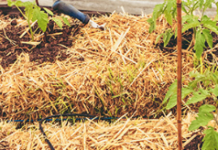We are getting into the vegetable garden season time. In fact many of you have planted peas and potatoes already! Soil preparation is always a need in the fall and this time of year to help insure great results. This is a reminder for adding organic matter and the benefits to the soil.
Fertilizers
The nutrient elements required by plants can be supplied by organic or commercial fertilizers. All plants re-quire 17 nutrient elements for growth. Fourteen of these come from the soil. When organic fertilizers are used, they must break down to release fertilizer elements to inorganic ions in the soil that plants can use. It makes no difference whether the fertilizer is organic or chemical as long as essential nutrients are there. In addition to providing nutrients, organic fertilizers improve the physical condition of the soil. However, organic materials must be used in large quantities compared to commercial fertilizers, which are more concentrated.
Organic Fertilizers
Organic matter is vital. When incorporated into the soil, decaying organic residue serves several useful functions:
o Loosens tight clay soils to provide better drainage.
o Provides for better soil aeration which is necessary for good root growth.
o Increases the water-holding capacity of all soils. This is especially helpful on sandy soils.
o Makes soil easier to till and more easily penetrated by plant roots.
o Supplies nutrients for plant growth.
Composting
Compost is composed largely of decaying plant materials. It can be made by piling any type of plant material such as leaves, cornstalks, weeds, straw, sawdust, waste hay, garden trash or other waste material into a pit, pile, or enclosed bin. The addition of small amounts of commercial fertilizers and garden soil to each bushel of material will speed the decaying process and increase the fertilization value. Keep the pile damp and turn or stir it occasionally. Use the compost from last summer and fall on next spring´s garden at the rate of 1 to 2 bushels per 100 square feet. This would equal a ¼- to -inch layer spread over the surface of the soil.
Other Organic Fertilizers
Stable manures – Use 1 to 2 bushels per 100 square feet. This would equal a ¼ to inch layer spread over the surface of the soil. This type of manure includes both fresh and dried cow or horse manure.
Poultry and sheep manure -These are more concentrated forms of manure and should be used more sparingly. The recommended rate is ½ bushel per 100 square feet.
Rotted sawdust, shredded leaves, cornstalks and other plant residue – These materials should be composted six months to a year before being used. Use 3 to 4 bushels per 100 square feet or about ½-inch layer spread over the surface.
Feedlot manure – This concentrated manure should be used sparingly, ½ bushel per 100 square feet. Excessive use of this manure may build up salt contents in the soil.
Note:
Organic fertilizers should be mixed into the soil before planting.



